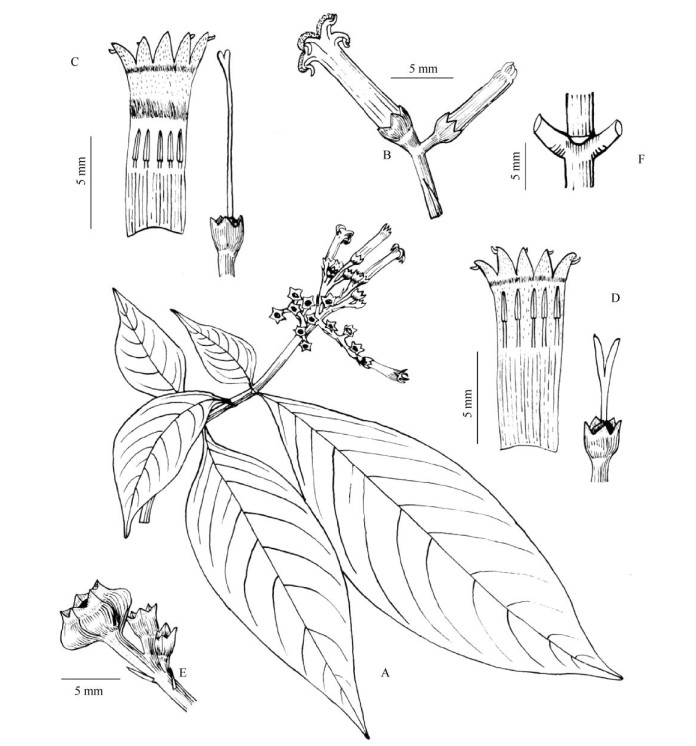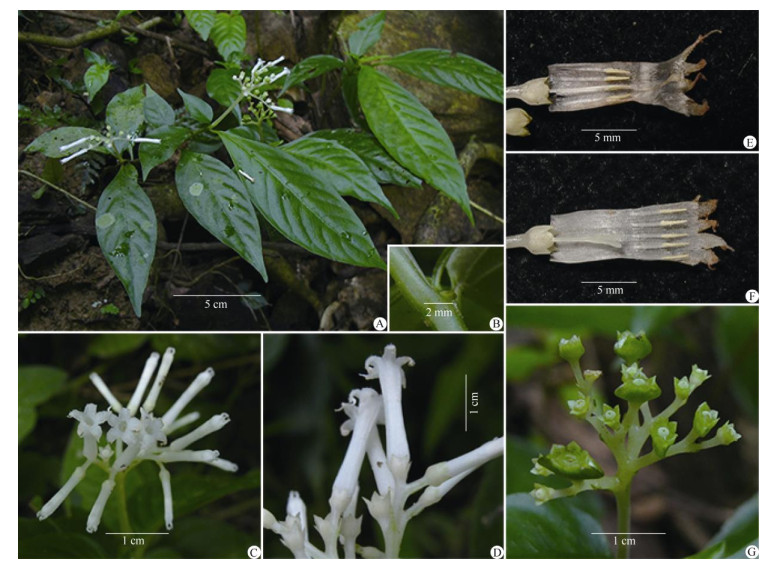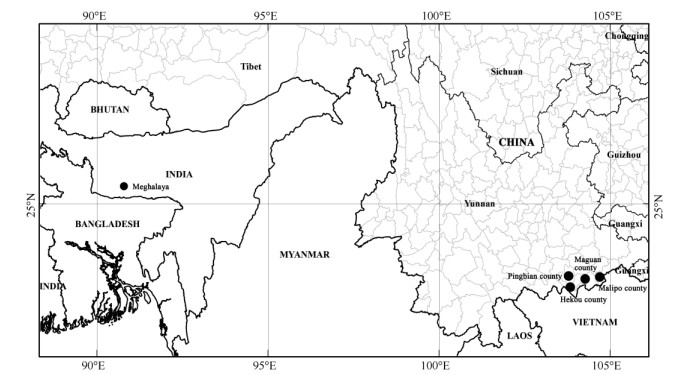2. 北京师范大学生命科学学院, 北京 100875
2. College of Life Sciences, Beijing Normal University, Beijing 100875, China
Ophiorrhiza L. (Rubiaceae) is an Indo-Malesian genus consisting of approximately 319 species world- wide[1]. Most representatives of the genus are annual or perennial herbs or rarely sub-shrubs and generally distributed in wet places under dense evergreen forests[2–6]. They can be easily distinguished from other genera of the family by their obcordate, com- pressed fruits that are dehiscent with two valves along a transverse slit at the top[2, 7–10]. However, species delimitation is sometimes very difficult due to their high morphological variation and insufficient know- ledge of flowers in most species[9–12]. Thus, misidenti- fication occurs often in the genus[12].
Ophiorrhiza gracilis Kurz was firstly reported as a new record for China by Luo in 1990 based on several specimens collected from southern and south- eastern Yunnan, China[3]. Later, it was also recognized in some floras of China[4, 13–15]. However, it was found that the descriptions made by Luo did not match with the protologue or the type specimen of O. gracilis in several characters. For example, Luo described leaf blade shape as ovate-lanceolate to elliptic, leaf blade apex as acute or acuminate, corolla tube as 9–10 mm long, corolla lobes as with dorsal horns 0.6–1 mm long, while O. gracilis has oblong-lanceolate to lanceolate leaf blades, caudate to long acuminate leaf blade apex, 7.5 mm long corolla tube, and corolla lobes without dorsal horn. Hooker noted that the most distinct character of O. gracilis was its leaf blade apex with very long slender points[11]. Subsequently, Deb and Mondal made a detailed description of O. gracilis and provided an illustration, which showed that the corolla of the species was 6–8 mm long and there was no horn at the apex of dorsal part of the corolla lobes[16]. Thus, we assumed that the specimens of O. gracilis from China were probably misidentified. After studying the relevant literature, carefully examining specimens in the herbarium and observing populations in the wild, we confirmed that the species described as O. gracilis by Luo is not the "real" O. gracilis but identical with O. caudipetala Deb & Mondal in many characters, such as leaves usually in distinctly unequal pairs, similar leaf blade shapes, cymose inflorescences, heterostylous flowers, tubular corollas, the same indu- mentum inside the corolla and corolla lobes with a horn on the back. Ophiorrhiza caudipetala is reported to be only distributed in India and never recorded in China[3]. Therefore, it represents a new record for the flora of China, so we hereto provide a detailed descri- ption and line drawing based on collections from China as well as a color plate.
Ophiorrhiza caudipetala Deb & Mondal in Kew Bull. 37(3): 483. 1982; Deb & Mondal, Bull. Bot. Surv. India 39: 36, f. 16. 1997. (Figs. 1 & 2)

|
Fig. 1 Ophiorrhiza caudipetala. A: Flowering branch; B: Flowers, side view; C: Long-styled flower; D: Short-styled flower; E: Fruits, side view; F: Stipule. [Based on Lei Wu & Xi-Bin Guo 3874 (BNU)] |

|
Fig. 2 Ophiorrhiza caudipetala. A: Habit; B. Stipule; C: Flowers, face view; D: Flowers, side view; E: Long-styled flower; F: Short-styled flower; G: Infructescence. |
O. gracilis auct. non Kurz: Luo in Bull. Bot. Res., Harbin 10(2): 77. 1990 et in Fl. Reipubl. Popularis Sin. 71(1): 169. 1999; Chen & Taylor in Fl. China. 19: 269. 2011; Wang et al. Species Catal. China. 1: 1388. 2019.
Type: India, Meghalaya, Khasi Hills, alt. 1830 m, 4 June, 1886, C. B. Clarke 44072 (holotype CAL; isotypes A, BM, K-K000173151! & E)
Herbs, weak at base, sub-erect above, to 30 cm tall; stems slender, sparsely pubescent to sub-glabrous. Leaves usually in distinctly unequal pairs; petioles 3–30 mm long, glabrous or sub-glabrous; blade drying papery, adaxially olive-green, abaxially pale-green, ovate-lanceolate to elliptic, 2.5–12 cm×1.5–4 cm, adaxially glabrous, abaxially sub-glabrous, pubescent to sub-glabrous along the veins, base obtuse to rounded, shortly decurrent or attenuate, apex acute or acuminate, entire; secondary veins 6–9 pairs; stipules ovate-train- gular, small, 0.5–1 mm long, sub-glabrous, caducous. Inflorescence terminal, corymbose helicoid cyme, puberulent; peduncles 1.5–3 cm long; bracts and bracteoles similar, linear, 1.5–8 mm long, persistent. Flowers distylous, subsessile or pedicellate, pedicels to 2 mm long. Calyx campanulate; hypanthium 1–1.5 mm long; lobes ovate-triangular, 0.4–0.8 mm long. Corolla white, tubular; tube 8–10 mm long, outside glabrous, inside with a pubescent ring of long hairs above the middle in the long-styled form, densely villous at the throat in both form; lobes triangular-ovate, 1.2–2.0 mm long, densely scaly puberulent abaxially, dorsally with a horn 0.6–1 mm long. Stamens 5, epipetalous; fila- ments in long-styled flowers adnate below the middle of the corolla tube, in short-styled ones adnate above the middle of the tube, 0.5–1.5 mm long; anthers at the throat of the corolla, 1.5–1.8 mm long, linear, 2-lobed, dorsifixed, dehiscing longitudinally. Capsule 2.5– 3.5 mm×5–7 mm, obcordate, transversely compressed, sub-glabrous. Seeds numerous, angular. Flowering March to June; fruiting June to August.
New Chinese vernacular name: 尾瓣蛇根草(wěi bàn shé gēn cǎo)
Habitat: Ophiorrhiza caudipetala often grows in the valley or on the mountain slopes under dense forests from limestone areas at altitudes of 150 to 1 000 m. They are mainly accompanied by tree species of Beilschmiedia Nees, Cyclobalanopsis Oerst., Manglietia Blume, Sinopora J. Li, N. H. Xia & H. W. Li and Swida Opiz, shrub species of Ardisia Sw., Callicarpa L. and Lonicera L., and herb species of Begonia L., Leptomischus Drake and Elatostema J. R. Forst. & G. Forst.
Distribution: China: Yunnan (Hekou County, Maguan County, Malipo County and Pingbian County). India: Meghalaya (Khasi hills) (Fig. 3).

|
Fig. 3 Distribution of Ophiorrhiza gracilis (●) |
Discussion: Plants of Ophiorrhiza caudipetala from China are somewhat different from those from the type locality in having longer corolla tubes (8–10 mm vs. 4–6.25 mm). However, the length of corolla tubes is usually with a great variable range in most species of the genus. Ophiorrhiza japonica Blume, for example, bears corollas with a tube length from 9 mm to 14 mm, and this variation could sometimes be found among individuals within a population. Ophiorrhiza caudipe- tala is morphologically close to O. repens (Wall. ex G. Don) Bennet by sharing similar leaf blade shape, cymose inflorescences, and the special horn on the back of each corolla lobe.
However, it can be distinguished from the latter by the shape of the stipules, indumentum of corolla and the length of corolla tube and lobes. The detailed morphological differences between the two species are presented in Table 1.
| Table 1 A morphological comparison between Ophiorrhiza caudipetala and O. repens |
Conservation status: Although having a relatively narrow distribution, most distribution areas of this species are located in nature reserves, such as Dawei- shan National Nature Reserve, Gulinqing Provincial Nature Reserve of Maguan and Laoshan Provincial Nature Reserve of Malipo, or in places protected by local governments, so the risk of being endangered seems to be low. Thus, following the IUCN (2019) redist categories and criteria, the conservation status of this species is classified as NT[17].
Specimens examined: China. Yunnan: Hekou county, Nanxi town, Baisha River, in valley, under dense forests, alt. 150 m a.s.l., 28 May 2013 (fl.), Lei Wu 3919 (BUN, CSH & CSFI); Hekou county, Nanxi town, Longyinchong village, on limestone slopes under dense forest, alt. 840 m a.s.l., 29 May 2013 (fr.), Lei Wu & Xi-Bin Guo 3922 (BUN), s.d., Yunnan University 2421 (KUN); Malipo County, Tianbo Town, Yaoliu Village, on limestone slopes under dense forest, alt. 950 m a.s.l., 25 May 2013 (fr.), Lei Wu & Xi-Bin Guo 3874 (BNU); Maguan County, Qiangou Village, on mountain slopes under dense forest, alt. 900 m a.s.l., 9 June 1956, The Sino-Soviet expedition 3265 (KUN); Pingbian County, Baiyan Town, in valley, alt. 1 100 m a.s.l., 30 June 1953, Pin-Yi Mao 2287 (KUN).
Acknowledgments The authors are grateful to the staff of the herbaria HN, IBK, IBSC, K, KUN and PE for permission to examine specimens or catalogues online, and Mr. Xi-Bing Guo for field assistance.
| [1] |
TU R H, LI J L, WU L, et al. Ophiorrhiza gaoligongensis (Rubiaceae), a new species from Southwestern China[J]. Novon, 2018, 26(4): 351354. DOI:10.3417/2018309 |
| [2] |
DARWIN S P. The pacific species of Ophiorrhiza L. (Rubiaceae)[J]. Lyonia, 1976, 1(2): 47-102. |
| [3] |
LUO X R. Taxonomic revision of the Chinese species of Ophiorrhiza (Rubiaceae)[J]. Bull Bot Res, 1990, 10(2): 1-82. DOI:10.1002/chin.199509012 |
| [4] |
CHEN T, TAYLOR C M. Ophiorrhiza[M]//WU Z Y, RAVEN P H, HONG D Y. Flora of China, Vol. 19(Rubiaceae). Beijing: Science Press & St. Louis: Missouri Botanical Garden Press, 2011: 258-282.
|
| [5] |
HAREESH V S, SREEKUMAR V B, KUMAR K M P, et al. Ophiorrhiza sahyadriensis (Rubiaceae), a new species from Southern Western Ghats, Kerala, India[J]. Phytotaxa, 2015, 202(3): 219-224. DOI:10.11646/phytotaxa.202.3.6 |
| [6] |
LIU W J, QI G, KHANG S N, et al. Taxonomic studies on Ophiorrhiza in Vietnam: I. Ophiorrhiza hiepii and O. hainanensis, a new species and new record from northern Vietnam[J]. Phytotaxa, 2020, 429(1): 65-72. DOI:10.11646/phytotaxa.429.1.5 |
| [7] |
LIU H Y, YANG T Y. Rubiaceae[M]//HUANG T C, BOUFFORD D E, LOWRY P P, et al. Flora of Taiwan, Vol. 4. 2nd ed. Taipei: Department of Botany, National Taiwan University, 1998: 245-340.
|
| [8] |
LUO X R. Materials for Chinese Rubiaceae (Ⅱ)[J]. Guihaia, 1991, 11(2): 97-116. (in Chinese). |
| [9] |
SCHANZER I A. Systematic notes on Ophiorrhiza trichocarpon Blume (Rubiaceae) and some related species[J]. Thai For Bull, 2004, 2(32): 132-145. |
| [10] |
DUAN L D, LIN Q. Taxonomic notes on some species of Ophiorrhiza (Rubiaceae) from China[J]. Acta Phytotaxon Sin, 2007, 45(6): 870879. DOI:10.1360/aps06098 |
| [11] |
DUAN L D, LIN Q. Two new synonyms of Ophiorrhiza subrubescens Drake (Rubiaceae)[J]. Bull Bot Res, 2009, 29(1): 3-5. (in Chinese). |
| [12] |
WU L, LIU W J, Nguyen K S. Revision of three taxa of Ophiorrhiza (Rubiaceae) from China[J]. Phytotaxa, 2019, 387(2): 129-139. DOI:10.11646/phytotaxa.387.2.5 |
| [13] |
LUO H S. Ophiorrhiza[M]//WU Z Y. Flora Reipublicae Popularis Sinicae, Tomus 71(1). Beijing: Science Press, 1999: 110-174. (in Chinese)
|
| [14] |
CHEN W Q. Ophiorrhiza[M]//WU Z Y. Flora Yunnanica, Vol. 15. Beijing: Science Press, 2003: 53-84. (in Chinese)
|
| [15] |
WANG L S, JIA Y, ZHANG X C, et al. Species Catalogue of China, Volume 1 Plants, A Synoptic Checklist Ⅲ[M]. Beijing: Science Press, 2019: 1388-1591. (in Chinese).
|
| [16] |
DED D B, MONDAL D C. Taxonomic revision of the genus Ophiorrhiza L. (Rubiaceae) in Indian subcontinent[J]. Bull Bot Surv India, 1997, 39(1/2/3/4): 1-148. |
| [17] |
IUCN Standards and Petitions Committee. Guidelines for Using the IUCN Red List Categories and Criteria, Version 14[M/OL]. 2019. (202012-07) http://www.iucnredlist.org/documents/RedListGuidelines.pdf.
|
 2021, Vol. 29
2021, Vol. 29


